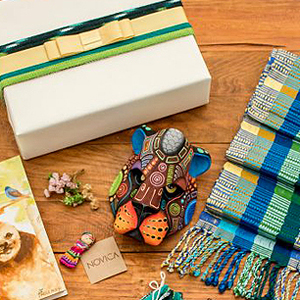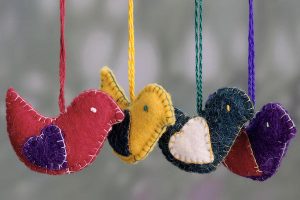Handmade jewelry - inspiration and challenges
The inspiration and challenges of a handmade jewelry artisan
Continued from story on Novica's Jewelry Home Page:
Fermin Vilcapoma is the son of Fernando Vilcapoma Quirre, a Peruvian silversmith who gained local popularity in the 1960s in Peru. While the elder Vilcapoma no longer works as a jeweler, he continues to help his son run the family business. Fermin Vilcapoma today proudly continues his father's legacy of excellence in handmade jewelry design, and has succeeded in bringing international attention to his own collection of extraordinary handmade jewelry.
Vilcapoma's popular handmade necklaces, bracelets, earrings, and rings feature high-grade Peruvian silver and a broad range of stunning gemstones. Many of Vilcapoma's handmade jewelry designs feature a distinctly Peruvian flair, and tend toward bolder shapes and weights while maintaining a distinctly classical sensibility.
"My designs are inspired by everything I see around me," Vilcapoma explains. "I'm inspired by the beauty of the individual gems themselves, and by our ancestors' jewelry. I enjoy the creative part the most. I absolutely love to design, and I also enjoy listening to my customer's suggestions, incorporating hints of their ingenuity as well."
Vilcapoma credits his father with helping him learn the jewelry trade from the ground up. That fortunate background, followed by decades of his own experience, helps Vilcapoma adapt to the evolving demands of the international market.
Sign of the times
"Until 1972, jewelry design was oriented largely towards gold," Vilcapoma explains. "Back then, clients would mainly buy jewelry featuring gold chains, gold rings, and bracelets. The market wasn't yet very interested in silver in those days. In fact, an ounce of silver then cost about $4 USD, whereas nowadays it's about $14 USD."
The following year, 1973, the world experienced a "revolution," as Vilcapoma describes it, in the price of gold. "People were selling even their own gold jewelry," Vilcapoma says, adding, "For jewelry designers, it wasn't worth working with gold anymore. We had to charge high prices for our jewelry -- prices that were beyond what the market could comfortably bear."
That year, Vilcapoma explains, jewelry artists began a significant stylistic shift that included lessening the weight of jewelry designs. Increasingly delicate styles of gold jewelry grew in popularity, while customers meanwhile began taking greater notice of silver and jewelers began shifting from gold to silver designs. By 1975, Vilcapoma says, instead of buying gold chain necklaces, for example, customers were buying silver chains -- often weighing 120 grams. At this same time in Peru, as a sign of the times, key chains featuring old silver coins gained considerable popularity. Silver had become the new popular jewelry standard. By 1978, Peru began to significantly increase its export of silver jewelry.
"When I finished high school in the 1970s, my dad asked me to join him as a fulltime silversmith," Vilcapoma says. "But at that time, despite my passion for jewelry design, I really wanted to explore life and travel, before settling down to my career. I joined a group of backpackers and traveled throughout Peru. During these travels, I found myself carefully observing tourists, especially noting their particular interests in our traditional jewelry."
Eventually Vilcapoma returned home to begin designing for his ultimate goal: the international market.
By 1982 Vilcapoma worked fulltime as a silversmith. In 1988 he finished creating his first significant collection, which he succeeded in exporting to England, thanks to a contact he had made during his backpacking days. Meanwhile, a local trader saw Vilcapoma's work. Impressed, the trader helped Vilcapoma begin placing his handmade jewelry in new venues. Soon, Vilcapoma realized he needed to hire assistant jewelers to keep abreast of increasing orders.
As international demand for silver jewelry grew, production capacity necessarily had to grow with it, Vilcapoma explains. New casting machinery arrived in Peru, and soon began replacing handcrafted processes at many jewelry workshops, offering the advantages of faster and more uniform production.
"I preferred to continue working with my hands," Vilcapoma says. "So I needed to hire more silversmiths who were also willing to continue working with their hands. Handcrafted jewelry continues to have a greater value than machine-made jewelry, and for me, art made by machines will never equal art made by hand."
The business of an evolving marketplace
Vilcapoma stays up-to-date on handmade jewelry trends and techniques by attending frequent courses, ranging from ancestral silversmith processes, to delicate filigree techniques, to gemstone-setting advancements -- all of which, Vilcapoma says, have helped him increase his knowledge, skills, and business acumen as an artist.
Vilcapoma says he also take regular courses focused on various aspects of business administration, so that he can better guide and manage his workshop, with a view to growing his business while adjusting to the changes in the market -- including the increasing price of silver.
"Especially for the last two years or so, our work as silversmiths has been affected by increases in the cost of silver," Vilcapoma says. "We are aware that this price increase is the result of silver being used more and more in industry. Since our local silver mines belong to foreign companies, we must abide by their price schedules. In Peru, we don't benefit from the subsidies that exist in various other countries. This has placed an increasing financial burden on our local handmade jewelry community."
Vilcapoma notes that various other factors influence the handmade jewelry trade, such as the added cost and risks of engaging in business internationally.
"Courier services refuse to fully insure our work," Vilcapoma says. "And they don't agree to assume full financial responsibility for our jewelry while in transit. That means that every time we send our jewelry to other countries, we must pray for its safe arrival. We must risk accepting a complete loss in order to compete internationally."
Another business obstacle that jewelers must manage is the fluctuating availability of gemstones, and their cost. For example, opals and chrysocolla are gemstones that were commonly incorporated in jewelry designs by Vilcapoma's Inca ancestors. These gemstones remain popular choices in traditionally-inspired Peruvian jewelry today. Vilcapoma explains that foreign companies have purchased expansive rights to the extraction of such gems in Peru, however, making it more difficult and costly today for local silversmiths to buy high quality, affordable gems.
"When we do manage to buy the gemstones we desire," Vilcapoma notes, "we often find the prices have even tripled."
Looking to the future
Vilcapoma is among the many enterprising artisan designers who have discovered the benefits of direct sales through the Internet, and he is taking advantage of this new business venue with great success.
"Through the Novica Web site alone, I have sold more than $100,000 USD in just one year. Thanks to that recent major breakthrough, and the international exposure the Internet offers to me as an artist, I now enjoy increased financial success and artistic renown. I now receive regular invitations to jewelry conferences, and my workshop's name is beginning to appear on exporters' ranking lists. For this new recent success, and for a lifetime of overall good fortune, I am eternally grateful."
Looking to the future, Vilcapoma says he will continue to invent exciting new handmade jewelry designs, and to fashion them of the highest quality materials.
"This allows me to survive in today's highly competitive market," Vilcapoma concludes. "Long ago I realized that the best way for me to survive in this fluctuating market is to constantly develop new jewelry designs, and to never give up the handcrafting processes. Handmade jewelry is an art form. It brings a special kind of value to the ever-changing jewelry world, a value that will never be lost."
Fermin Vilcapoma's biography and most recent collection can be found on NOVICA's Jewelry Home Page.












